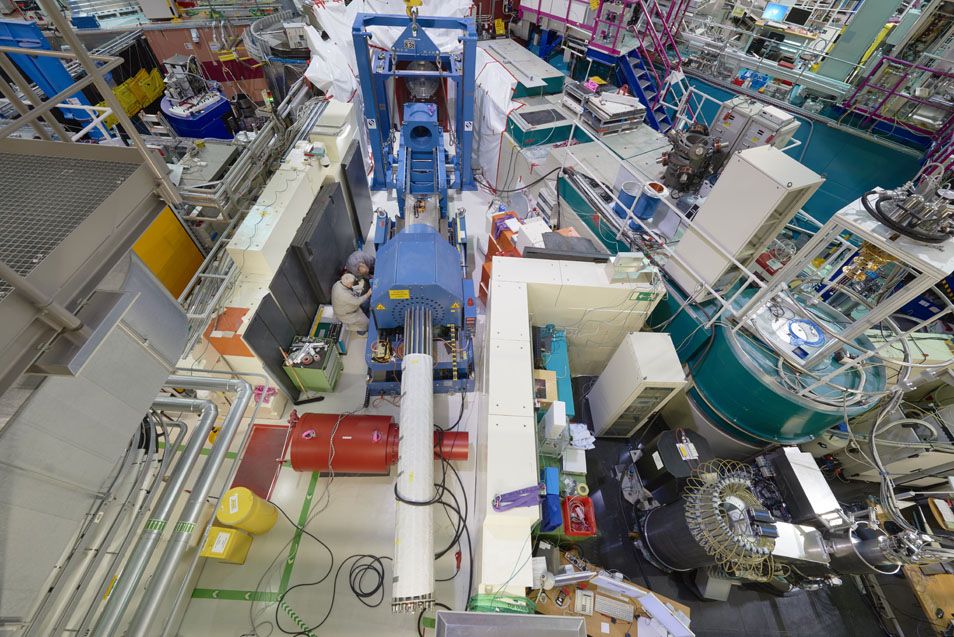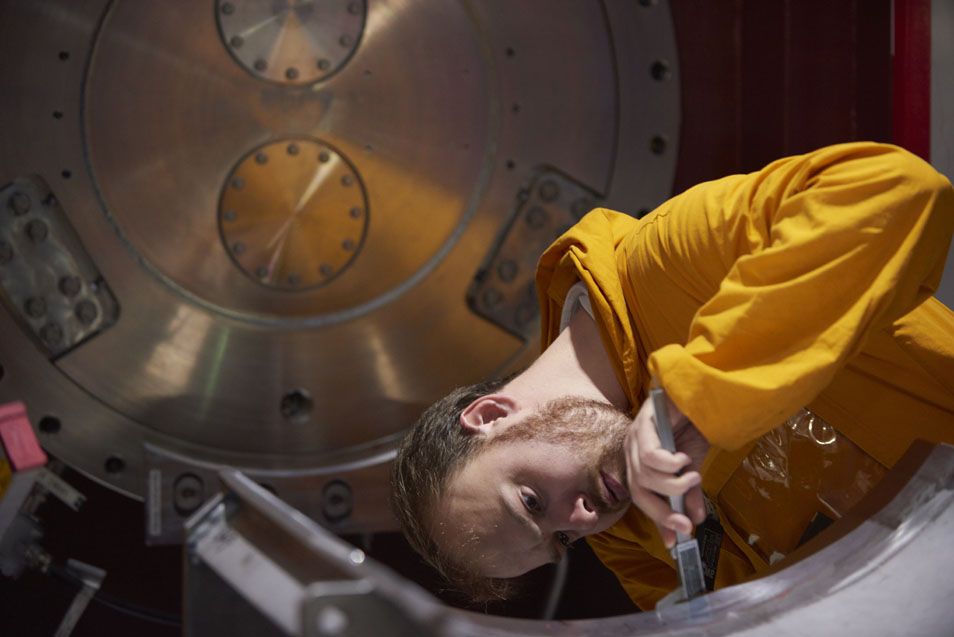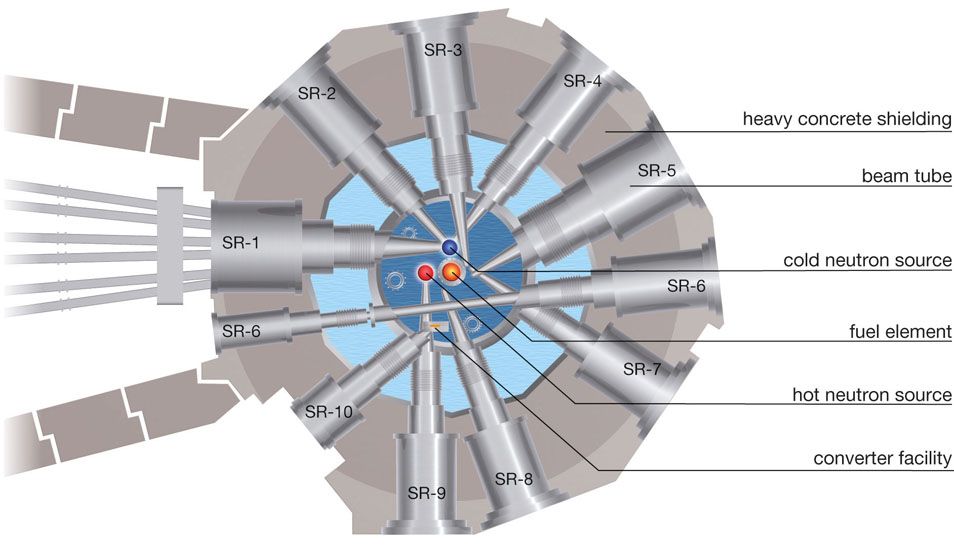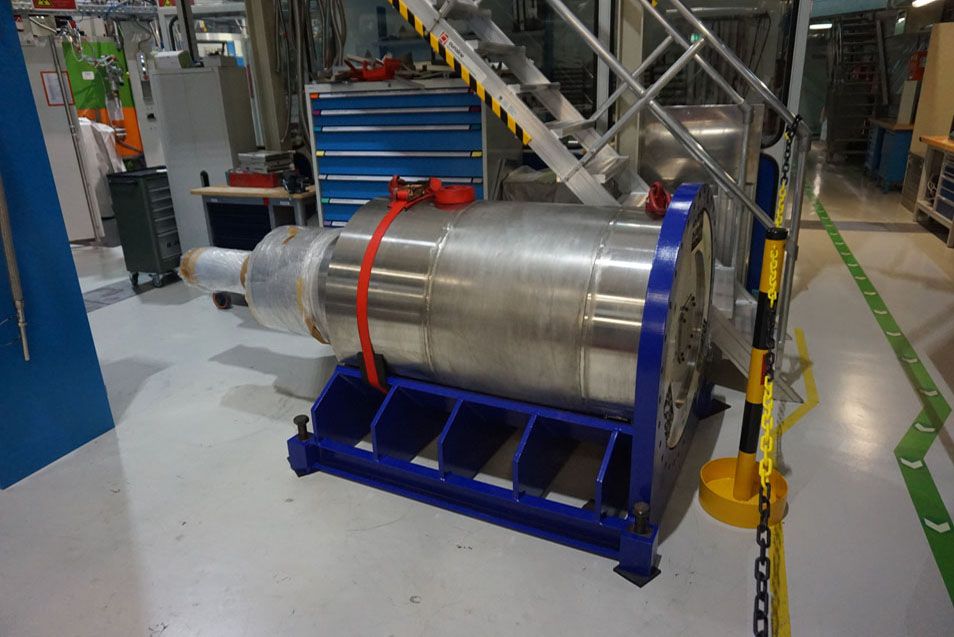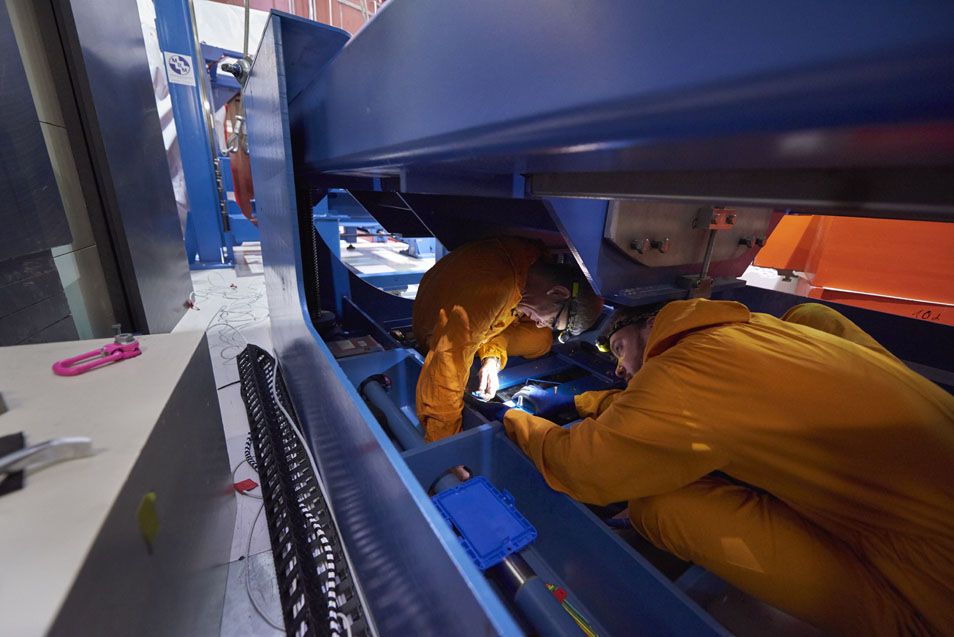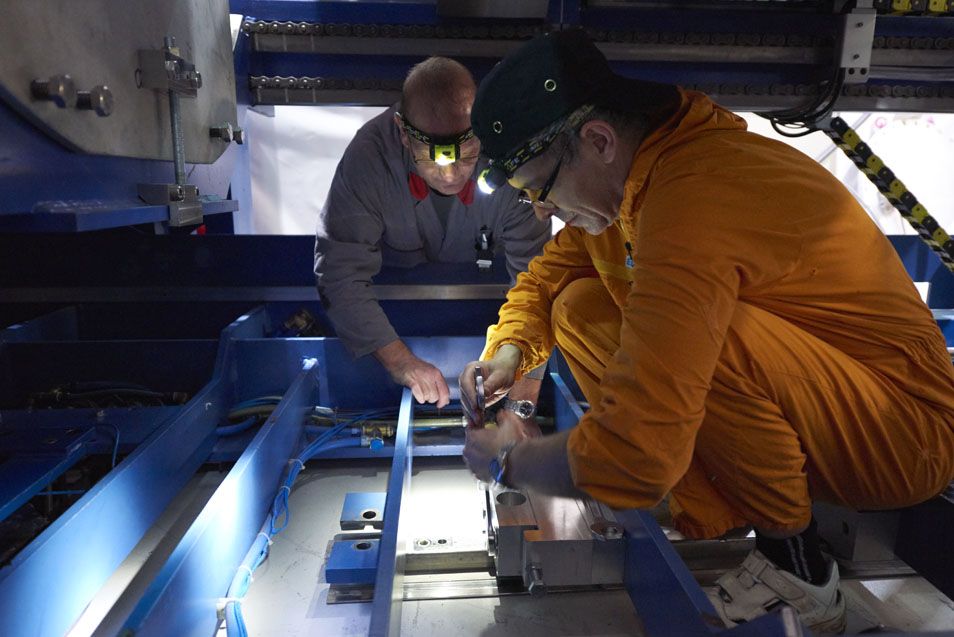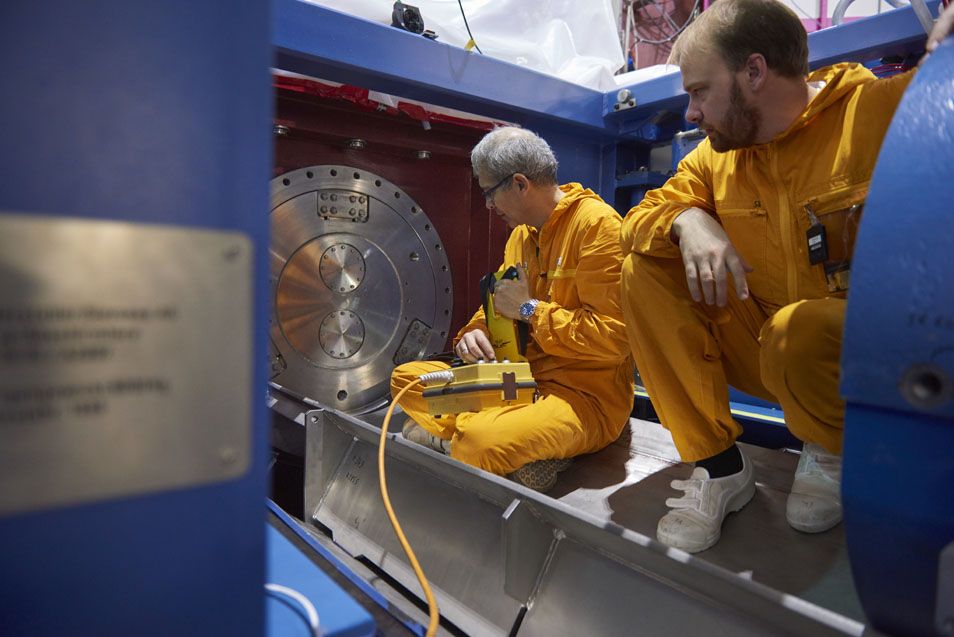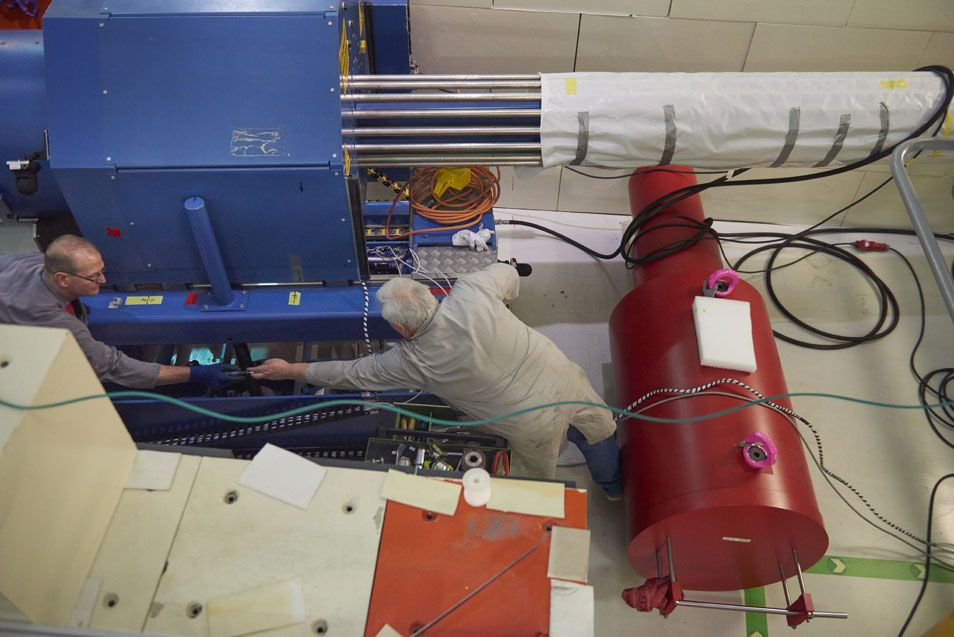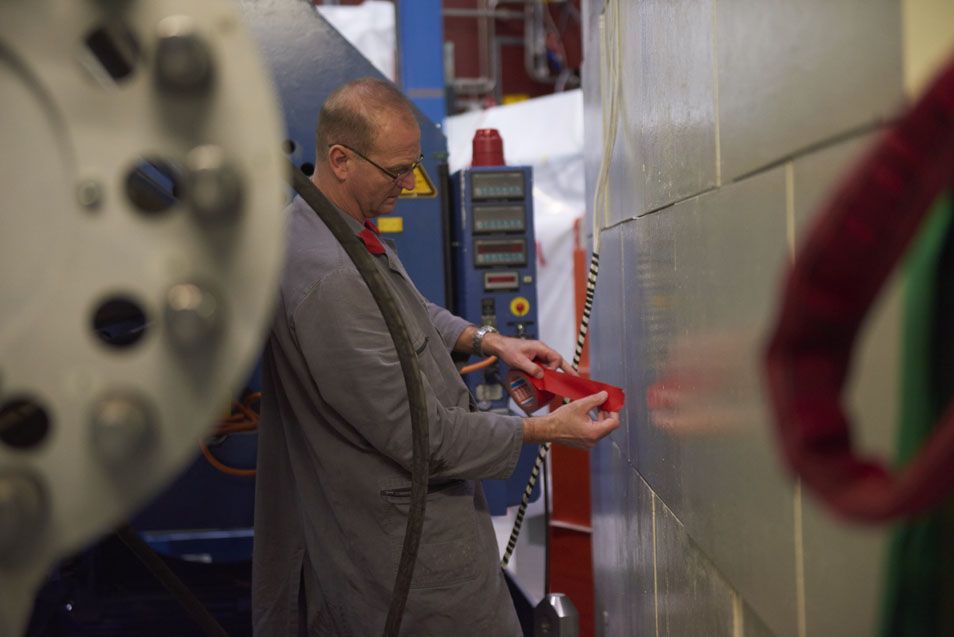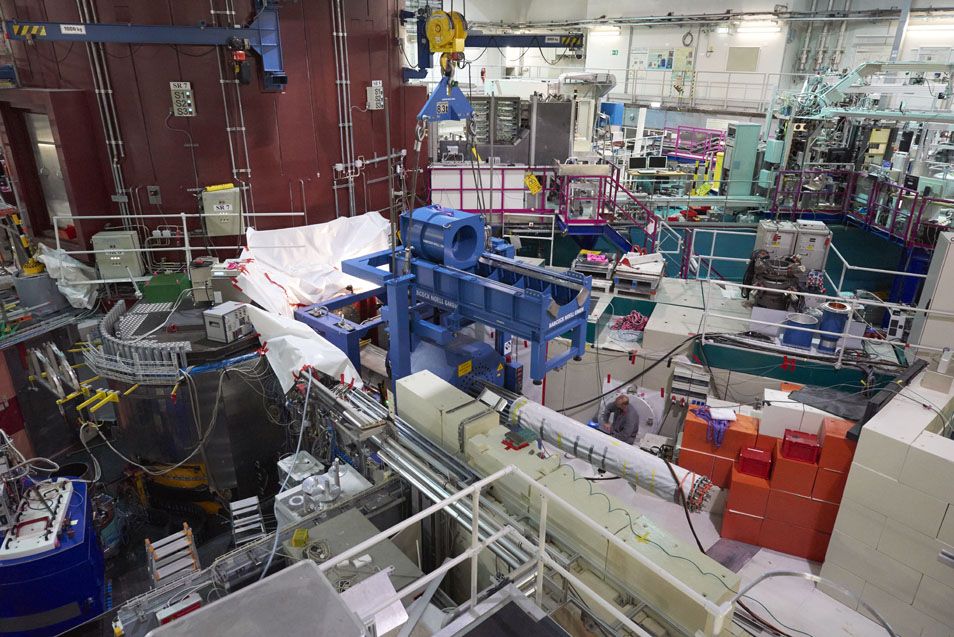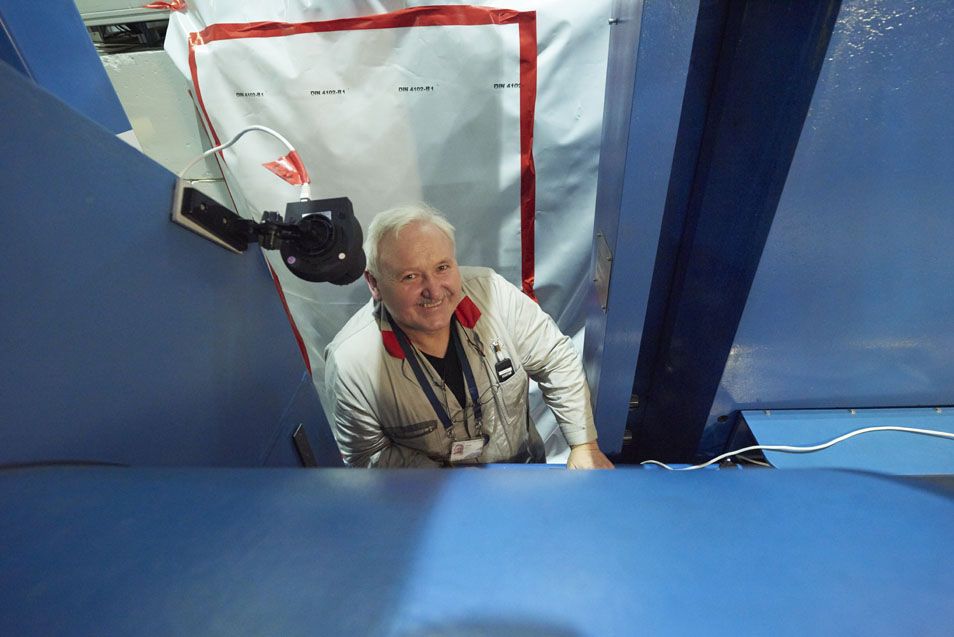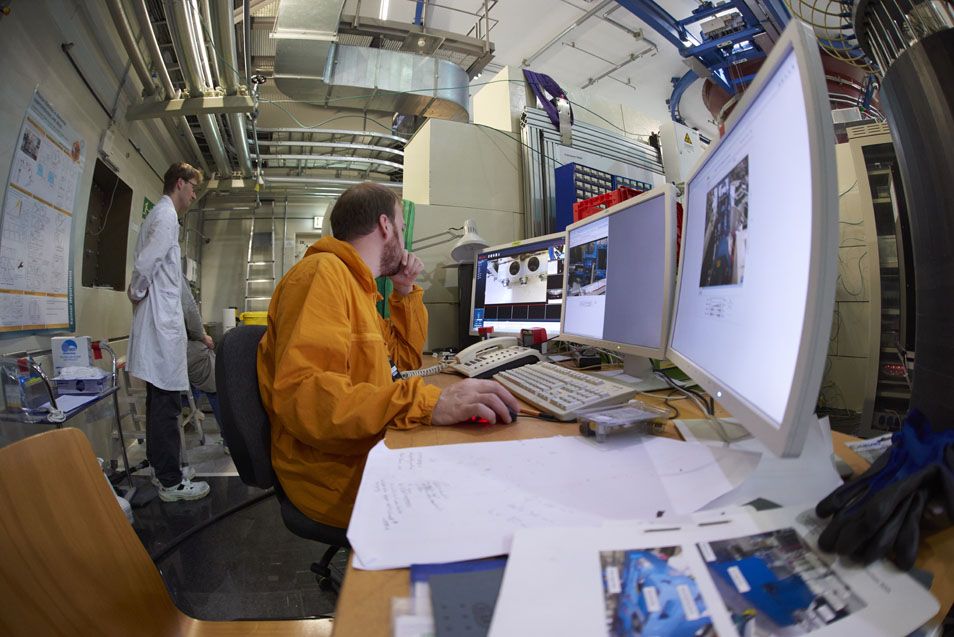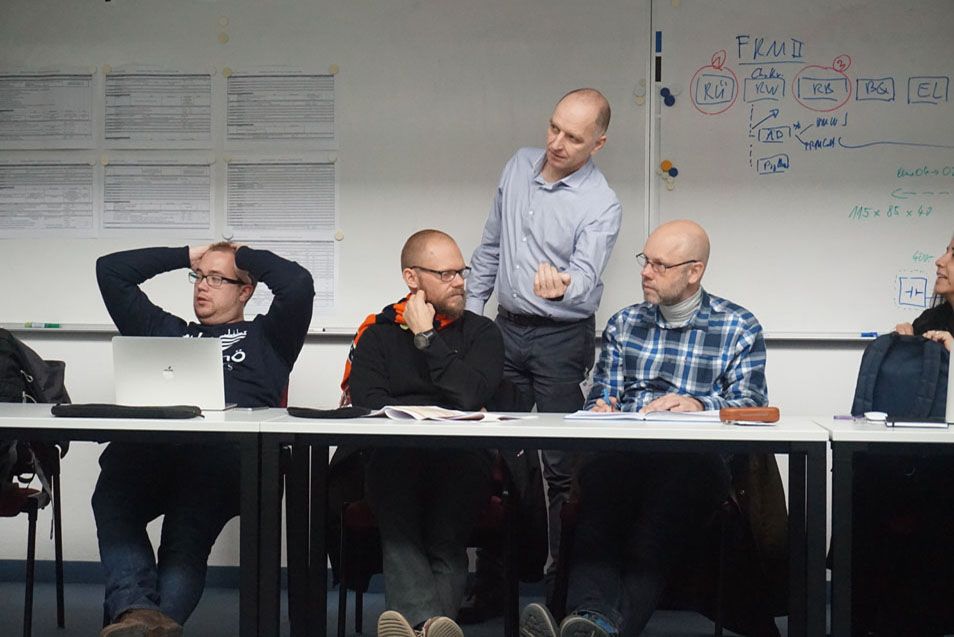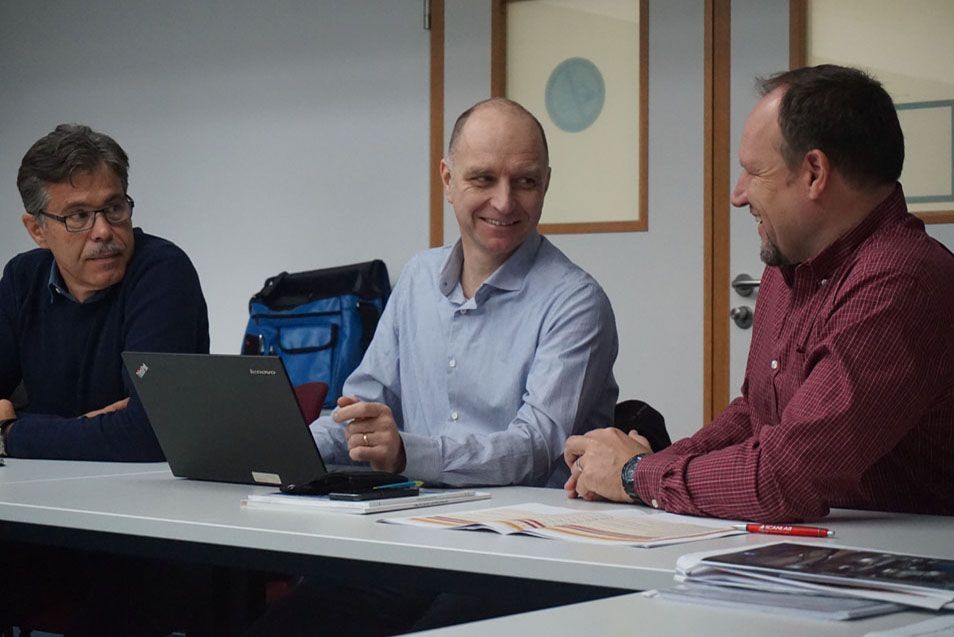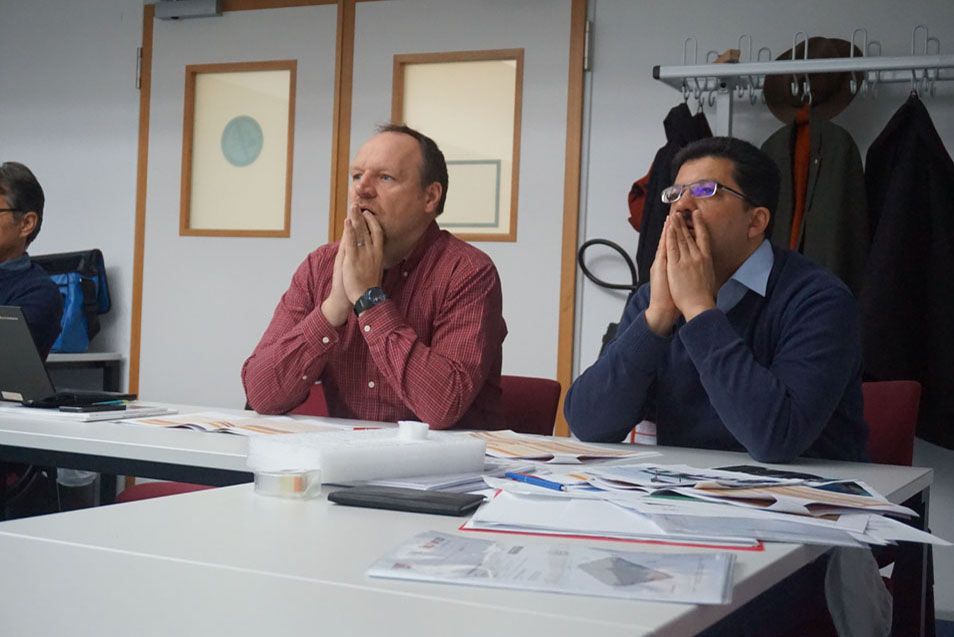MLZ is a cooperation between:
 > Technische Universität München
> Technische Universität München > Helmholtz-Zentrum Hereon
> Helmholtz-Zentrum Hereon
 > Forschungszentrum Jülich
> Forschungszentrum Jülich
MLZ is a member of:
 > LENS
> LENS > ERF-AISBL
> ERF-AISBL
MLZ on social media:

MLZ (eng)
Lichtenbergstr.1
85748 Garching
Plugs, rays and a very special machine
This particular Tuesday during the maintenance break is a special day at the FRM II: the Experimental Hall has already been closed for a few days, an extraordinary machine stands between the test setups next to the reactor pool and several technicians and engineers wearing orange overalls are walking around busily. The exchange of the beam plug is imminent. After preparatory work lasting two and a half years, this precision task is finally going to be undertaken the following day: In the first essential part of the whole project, the beam plug is going to be pulled out.
“The reason for the exchange is not due to any defectiveness of the old plug”
The plug in the beam tube is, in fact, a lock. Ten beam tubes with a helium atmosphere are responsible for transporting neutrons from the Neutron source in the moderator tank to the experiments. The beam plugs as well as the shutters close these openings in the 1.8 m thick wall of the reactor pool.“The reason for the exchange is not due to any defectiveness of the old plug”, Dr. Herbert Reithmeier, nuclear physicist and head of the infrastructure department at the FRM II, clarifies. The point is that the previous beam plug was a blind one, locking the beam tube 6 completely. This beam tube is the only horizontal tube that runs through the reactor pool, going from the Experimental Hall to the Neutron Guide Tunnel. In order to be able to connect the beam tube to the foreseen experiments, a new special plug with a central channel is required.
The actual process of exchanging the beam plug was planned, prepared and rehearsed for a long time in advance.
© FRM II / TUMAn important step for the UCN-project
The exchange of the beam plug is thus an important step, in promoting the commissioning of the ultra-cold neutron source that will expand the scope of research at FRM II in the future. Ultra-cold neutrons (UCN) move extremely slowly, almost with the same speed of a very calm cyclist (<10 m/s), and can therefore be observed very exactly. The scientific applications of ultra-cold neutrons are diverse and include fundamental research as well as possible explanations of the imbalance of matter and antimatter in the universe
The actual process of exchanging the beam plug will take approximately 45 minutes, but it was planned, prepared and rehearsed for a long time in advance. Elbio Calzada works as a mechanical engineer at the FRM II and is the project manager responsible for the plug exchange. Together with his team, he has worked out all the technical features of the project, so that an exact procedure may be followed:
The beam plug is slowly pulled out of the beam tube, using the remotely controlled “beam-plug-changing-machine”, far enough to allow the steel shielding gates, in front of the opened beam tube, to be closed. The plug is then moved backwards to create the exact space for the support device with the shielding bottle, which is lowered slowly from above. Subsequently, the “beam-plug-changing-machine” changes direction and pushes the beam plug onto the support frame and into the shielding bottle. Then the plug and shielding bottle will be fixed to the transport device and subsequently disconnected from the “beam-plug-changing-machine”. Finally, the shielded beam plug is placed with the Hall crane in a suitable transport container. The new plug will then be inserted a few days later.
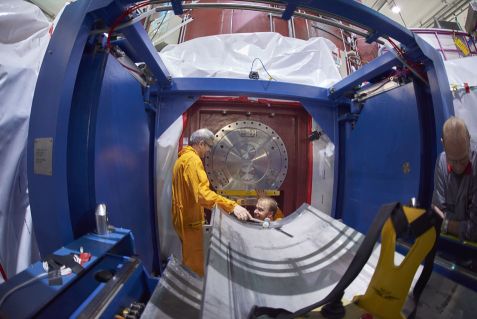
The essential point behind a project of this magnitude is a team that can rely blindly on each other. © W. Schürmann / TUM
“The complexity arises from the many individual critical operations”
One of the many major challenges in exchanging the beam plug is that the five-ton colossus was made radioactive during its time in operation. Having been located quite close to the fuel element for more than a decade, the plug now shows a local dose rate up to 5 Sv/h in its immediate vicinity. Crucial is a thin steel plate, only 5 millimeters thick, situated at the very tip of the beam plug but in which 99 percent of the radioactivity is concentrated. What exactly will happen to this radiating component after the exchange? “As only the front part is radioactive, the plug will be split into two parts by our external partners in Karlsruhe”, Dr. Reithmeier explains. “We will take back the bigger and inactive part, the rest of the plug is radioactive waste that will be treated appropriately and put into interim storage; later it will be taken to the Federal repository Schacht KONRAD.”
Handling a relatively highly active component involves many questions that, in part, have to be clarified, approved and prepared several months in advance. What happens if the lifting device malfunctions at a critical moment? How to react in the case of a power failure? Who can take over the duties of a team member who unexpectedly falls ill? “The complexity of the project arises from the many individual critical operations, each of which can call into question the target deadline or can give rise to serious technical problems,” Reithmeier points out. Technical solutions such as, for example, a redundant lifting system and the meticulous planning of the security- and emergency measures minimize the safety risks step by step. The well-prepared conceptualization behind the exchange and the specific sequence plan have been examined in detail and approved via so-called “change notifications” by the supervisory authority. The same thing applies to important technical tools such as, for example, the transport frame or structural modifications within the Experimental Hall itself. These complex and exact preparations are self-evident for the nuclear scientist since the security of the employees always ranks first.
Practice, practice and trust in each other
Above all, the plug exchange is run-through over and over again, until every movement has been tried and tested, optimized and incorporated into the sequence plan down to the last detail. “Our aim is to handle the standard case perfectly, in order to be able to calmly contemplate any unexpected event and therefore create enough mental breathing space” Herbert Reithmeier explains. Many training sessions have taken place in a neighboring building and finally were carried out on-site under real conditions.
The essential point behind a project of this magnitude is a team that can rely blindly on each other. Elbio Calzada, project manager of the plug exchange also emphasizes that: “Everyone has his own task to fulfill, however each member of our team is able to perform every task. Good communication, and mutual esteem are crucial and they are present here in abundance. I am very grateful for that.”
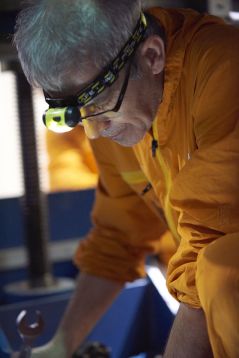
Project manager Elbio Calzada examines each screw. © W. Schürmann / TUM
“High accuracy despite very heavy equipment”
Exact alignment of the “beam-plug-changing-machine” is vital to the success of the project. On the one hand, this unique piece of equipment has to be positioned precisely between the facilities for experiments that are packed closely together and, on the other hand, it has to be aligned accurately with the beam tube and the beam plug itself. To achieve this, some experimental facilities have to be modified or even partly dismantled and reassembled. In view of the limited space, this requires great dexterity and finesse. “Despite the very heavy equipment, the project requires high accuracy”, Reithmeier remarks aptly.
Calzada is responsible for the control of the “beam-plug-changing-machine” that is about eight meters long and weighs ten tons. He is in charge of positioning the machine exactly with the help of air cushions as no adjustment is possible during the “hot phase”. The machine will subsequently only move in a straight line, backwards or forwards, by pulling or pushing the beam plug. Therefore, the axes of the beam tube, the beam plug and the “beam-plug-changing-machine” have to be aligned perfectly so that the beam plug, in its close-fitting housing, does not get stuck. The margin for error is less than two millimeters. Adjusting the machine requires a lot of physical effort, because the workplace is extremely narrow. Calzada and his colleagues examine each screw and concentrate all their efforts on the machine as everyone understands the importance of this task. Even if the setups appear motley and confusing at first glance: Each cable has its proper place and nothing is left to chance.
During and immediately after the removal of the beam plug, nobody is allowed to stay near the device on account of the radiation. Not before the front part of the plug has been radiologically shielded and the local dose rate reduced to an acceptable value of 50µSv/h. The interval when the beam plug stands outside of the beam tube in the room without shielding is called the “hot phase”. The team operating the “beam-plug-changing-machine” therefore stands behind a protective shielding wall during the entire procedure. Consequently, there is no direct view of the “beam-plug-changing- machine” or the beam plug. In order to still be able to determine the exact position of the machine at any time, the technicians installed a total of eight cameras at strategic points and marked every significant set position exactly. The video is transmitted in real time to several screens so that the operators are able to move the “beam-plug-changing- machine”, the lifting system, the shielding gate and the hall crane accurately via remote control.
Final rehearsal successfully completed
The day before the actual event, the small team of engineers and technicians responsible for exchanging the beam plug holds a final rehearsal. Working under real conditions, they move a special dummy-plug which duplicates the original in weight and dimensions. Every single step of the sequence plan is carried through and monitored. Calzada manoeuvres his machine with a steady hand, the months of practice and preparation pay off and the harmless but impressive dummy is in the process of being secured and shielded.
The moment of truth arrives the following day: Will everything go according to plan? The Experimental Hall is in complete lock-down and even Dr. Reithmeier has to take his place among the spectators outside the Experimental Hall. There are now only eight people inside the Hall, including Elbio Calzada with his team, two official experts from the licensing and supervisory authorities and two radiation protection technicians. Colleagues travelled especially from other institutes in Switzerland and Sweden to witness the event and learn from it for their own projects. Together with representative of the supervisory authority, they follow the procedure live via video broadcast in the transmission room.
Suspense in the transmission room
At exactly 9 a.m. the time has come. By this point, Elbio Calzada’s crew has been through more than 100 training sessions – the atmosphere in the transmission room is accordingly optimistic. Nevertheless, a hush falls when the plug is completely pulled out of the tube and the steel gates close slowly. Are the calculations of the anticipated radiation dose correct? The scientists in the Experimental Hall check the actual dose via a preinstalled sensor located at a distance of three meters from the exposed plug. They hold the display of the sensor towards the camera and excitement spreads among the spectators: The camera zooms into the display, focuses and finally everybody in the transmission room sees the real value: 6.5mSv/h. “Yeah!”, Reithmeier shouts enthusiastically, “exactly like the simulation!” and his colleagues are also visibly impressed: “Great, Amazing”, “very good”. The results give rise to many appreciative looks since the actual values are just slightly below those calculated. Herbert Reithmeier is visibly relieved.
The team in the Experimental Hall focuses on carrying out every subsequent step of the sequence plan. The transport frame with the shielding component is lowered, the lifting device works properly. It gets exciting once more when the beam plug is inched towards the blue shielding bottle. Is everything adjusted correctly? The technicians control the placement of the beam plug slowly into the shielding and it fits! The radiation measurement is crucial now. For the first time, people appear in the working area. Holding dosimeters and telescopic measurement devices the radiation protection technicians approach the shielded beam plug carefully – soon afterwards they give their okay. Herbert Reithmeier quickly packs up the most important documents and, accompanied by the official expert from the supervisory authority, hurries to the Experimental Hall. The plug is secured and packed, the “hot phase” is over and he wants to be on site again for the operation of the crane.
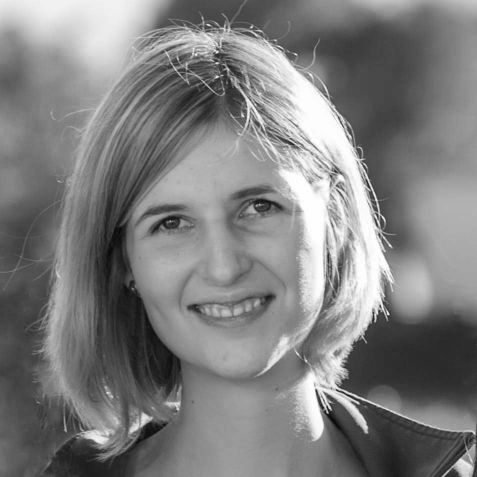
Teresa Kiechle
Press & Public Relations
FRM II
MLZ is a cooperation between:
 > Technische Universität München
> Technische Universität München > Helmholtz-Zentrum Hereon
> Helmholtz-Zentrum Hereon
 > Forschungszentrum Jülich
> Forschungszentrum Jülich
MLZ is a member of:
 > LENS
> LENS > ERF-AISBL
> ERF-AISBL
MLZ on social media:



